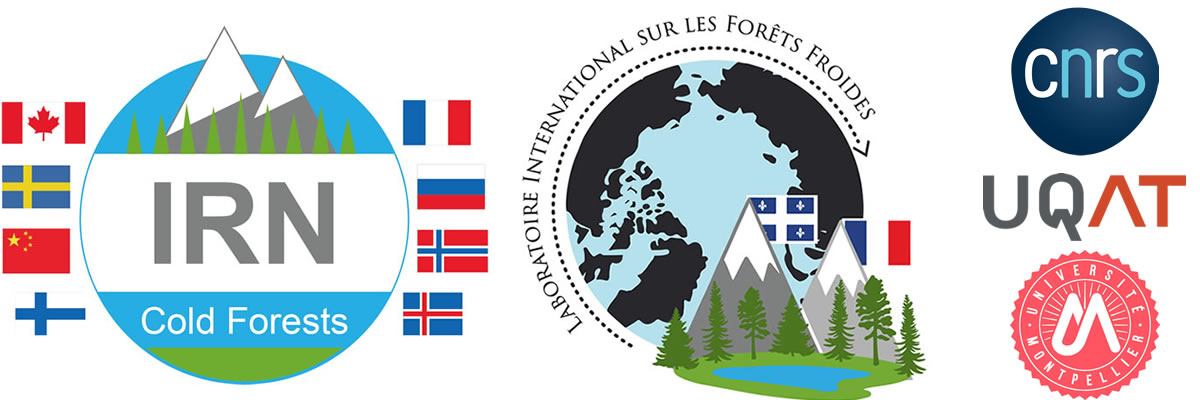Climate dynamic & fire risk
Theme 2.1 – Paleoclimatic reconstructions using chironomids and pollen data
► Odile Peyron (ISEM, France) & Emmanuel Guandouin (IMBE, France)
► Theses involved: Cheïma Barhoumi & Gwenaël Magne
Our goal is to quantify major climatic changes during the Holocene using an approach based on several biotic indicators. Assemblages of chironomids and pollen extracted from lake sediments collected under this project will be used to quantitatively reconstruct temperature and precipitation variation during the Holocene. Chironomids are insects belonging to the Diptera family with a larval stage that is aquatic and a life cycle strongly influenced by temperature. Many studies have highlighted the major role of summer temperatures (July) on the large-scale geographical distribution of chironomid assemblages in some lakes. It is this relationship between summer temperature and community composition that will be used to mathematically quantify (WAPLS) paleotemperatures from chironomids (Larocque et al. 2006; Brooks et al. 2012).
We will also use pollen data extracted from the same lacustrine sediments and analyzed by this consortium to estimate with a high temporal resolution the temperature fluctuations (warmest / coldest month) and precipitation (Peyron et al. 2005) during the Holocene using different methods (Peyron et al. 2011). This approach will therefore integrate different methods of quantitative recovery of palaeoclimates including methods based on assemblages and transfer functions (Braak and Juggins 1993; Goring et al. 2009), to reduce the uncertainties associated with the use of a single method and provide more reliable estimates of climatic parameters. The results obtained in this project will provide a better understanding of reconstructed local and regional signals and will also be compared with previous studies, including climate reconstructions in North America based on the modern analog technique developed by Viau et al. (2006) and Viau and Gajewski (2009).
Theme 2.2 – Comparing proxy-model & modeling
► Christelle Hély (ISEM, France) & Martin Girardin (CFS, Canada)
► Thesis involved : Dorian Gaboriau
We will simulate past climate using the BioSIM v11.1.0 software (Régnière et al. 2014) and the parameterizable climatic model proposed by the Pierre Simon Laplace Institute (PSLI; https://www.ipsl.fr/) Climate Modeling Center (CMC). The PSLI produces and disseminates simulations for various international programs. These simulations consist of climatic averages at 10-year intervals covering the last 6000 years. These climate simulations will then be related to the data from paleo-climatic reconstructions (Theme 2.1) of fire dynamics (Theme 1). This comparison of simulated and empirical data will show whether changes in fire frequency and vegetation are related to climate change and which are the most important climate variables and processes in these relationships (Hély et al. 2010).
Overall climate projections for the coming decades indicate an upsurge in Northern Hemisphere drought events and thus potentially an increase in fire in boreal and montane ecosystems. Whatever the source of ignition (lightning or anthropogenic), the development of drought conditions will indisputably modify the fire regime in the ecosystems that will be studied. An integrative tool dealing with the analysis of processes within ecosystems is therefore essential not only to analyze their long-term functioning, but also to understand and predict in the most objective way possible the response of these ecosystems to rapid changes in climate. From this perspective, one of the proven approaches is the use of Global Vegetation Dynamics models (GVDM). Among the different GVDMs available, the LPJ model and its different versions (LPJ-GUESS-Spitfire or LPJ-LMfire) is already used by our consortium and seems to be the most appropriate model to circumscribe past and future ecological trajectories. It is a generic model that takes into account the basic processes that control the functioning of an ecosystem (Smith et al. 2001; Lehsten et al. 2009), namely photosynthesis, respiration, and carbon allocations from primary productivity, functional intra- and inter-type plant competition, evapotranspiration mechanisms, decomposition of soil organic matter, tree mortality following a fire, burned biomass and CO2 emissions associated.
The CBM-CFS3 model (Kurz et al. 2009) is a model of forest growth that simulates aerial and underground carbon dynamics, including in soils. The model tracks carbon stocks, transfers between basins and emissions of carbon dioxide (CO2), methane (CH4), and carbon monoxide (CO). We will simulate carbon dynamics on fictitious territories with similar edaphic properties to the studied territories. After induced deglaciation and an installation period of 1000 years, disturbance rates and their temporal changes will be prescribed on a matrix of polygons based on the information extracted from lake sediment analyzes carried out in Theme 1. The curves and the forest succession rules required for the CBM-CFS3 model will be derived from forest inventory analyzes provided by Natural Resources Canada. The vegetation present over time will be determined and prescribed according to the information obtained from pollen analyzes carried out in Theme 2. The impact of climate and changes in solar radiation on photosynthesis will be introduced into the simulations via a modulating modifier (i.e., increasing and decreasing) growth curves (Coulombe et al. 2010). This modifier will be obtained through the use of a process-based photosynthesis model (StandLEAP; Girardin et al. 2011) and driven by temperature, precipitation and solar radiation data obtained using climate models of intermediate complexity (Hély et al. 2010).
Simulations from the two vegetation models (LPJ- and CBM-CFS3) will then be compared to confirm major trends of modifications that occurred during the Holocene and in the future, while accounting for differences between the models.
To feed the LPJ- and StandLEAP models, we will use simulations from the GCM HadCM3 (Hall and Valdes 1997), which produced simulations with time steps of 1000 years, as well as those of GCM LOVECLIM (Renssen et al. 2009) and IPSL-CM5, which have produced continuous simulations over the last 8000 and 6000 years, respectively. Simulations consisting of monthly climatic normals will be processed as described by Ramstein et al. (2007) and Hély et al. (2009) to produce monthly temporal climatic data, whereas normal or accelerated transient simulations will be used normally or redeployed, respectively.

